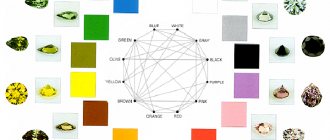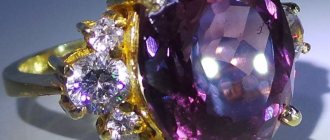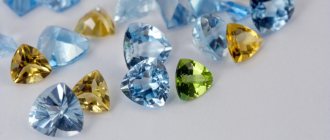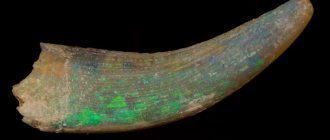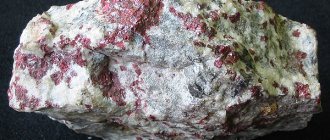This mineral is so diverse that it is simply impossible to confuse it with another gem. There are legends about him in many countries in different parts of the world. Opal can be both a gift and a curse. Not everyone is given the opportunity to find a patron in this gem - the stone will either open up new opportunities for the owner, or bring a person to the very bottom.
Historical reference
Opal was known to ancient peoples; beautiful and frightening legends were created about it.
Opal is mentioned in myths and traditions on all continents.
- The ancient Greeks associated it with the victory of Zeus over the Titans, after which the supreme god burst into tears of happiness. The tears that fell to the ground became rainbow opals. It was believed that the Zeus stone made the owner a fortune teller.
- Australian aborigines are confident that sparkling stones, called “desert fire,” remained on the site of the traces of the Creator of the World.
- Arabic legends claim that opals are the children of lightning, brought to earth. The stone can protect from thunderstorms or bad weather, and make a person invisible.
- In India, opals are considered parts of the body of the rainbow goddess. Fleeing from annoying gentlemen, she fell, crumbling onto beautiful stones.
For centuries, opal's purpose has been to bring good luck. But the fall from grace is ambiguous. To the Romans it represented hope and purity, but black opal was Caligula's favorite. This friendship became fatal for the emperor. Scandinavian sagas say that the opal stone was forged by the blacksmith god from children's eyes. The early Middle Ages is full of descriptions of dark rituals with opal in the leading role. Opal powder was a poison that was added to food.
The English King Edward VII, in order to protect himself from the influence of the gem, ordered the opals to be removed from the crown. Napoleon's wife Josephine laughed at this - and in vain. When the Burning Troy pebble moved into their home, the couple divorced. Then they began to say that the mineral allegedly self-destructed, dissolving into the air. This is possible, given the properties of natural opal. Clients refused the stones, and jewelers had no choice but to throw them away.
Myths and legends
There are many legends about light royal opal. According to myth, this mineral was created by God when he descended to Earth - together with the Creator, beautiful opal stones appeared that shone with all the shades of the rainbow.
Another legend says that one day the Egyptian queen Cleopatra saw an unusual crystal the size of a nut in one of her allies.
Struck by its brilliance and rainbow tints, she demanded that the mineral be given to her, but the henchman refused. Then the gem was taken from him by force and presented to the queen. Subsequently, a large ring was created from it.
Origin
A fragment of the jaw of the ancient mammal Kollikodon ritchiei, which became opal during the process of fossilization. It
has been scientifically proven that opals are petrified trees and skeletons of small animals. They formed in the ground or craters of volcanoes.
Forms of opal release: cluster-shaped or kidney-shaped aggregates of amorphous silica, cracks. It usually occurs among limonites, sandstones, rhyolites and basalts.
The origin is sedimentary, supergene or low-temperature hydrothermal. It occurs in the form of veins, filling cracks in the host rocks.
The rocks diatomite, tripolite and opoka are made up of scattered small particles of opal.
Opal forms various kinds of sintered forms or nodules, often forms pseudomorphs on various minerals, and also impregnates various animal and plant remains, forming fossils. Sometimes found in the form of earthy masses or fine powder.
Physical and chemical properties
Opal is amorphous silica, devoid of a crystal lattice. Semi-precious jewelry stone.
The color of opal varies, but all types have a common characteristic: pearlescent luster. The effect in which the glow comes from inside the stone and scatters across the surface is named after the stone - opalescence. Applies to other precious minerals.
Opals can be transparent or translucent. This determines the percentage of water in the stone: the more, the more transparent the gem. For the noble ones - strictly 6-10%.
| Color | Colorless, white, yellow, red, brown, blue |
| Stroke color | white |
| origin of name | from the ancient Indian upala - precious stone |
| Opening year | known since ancient times |
| IMA status | valid, first described before 1959 (before IMA) |
| Chemical formula | SiO2+H2O |
| Shine | glassy, greasy, waxy, pearlescent, dull |
| Transparency | transparent, translucent, opaque |
| Cleavage | not visible |
| Kink | conchoidal, uneven |
| Hardness | 5,5, 6, 6,5 |
| Thermal properties | Under the blowpipe it cracks a lot, but does not melt. |
| Luminescence | yellow-green (uranyl) |
| Strunz (8th edition) | 4/D.01-80 |
| Hey's CIM Ref. | 7.8.8 |
| Dana (8th edition) | 75.2.1.1 |
| Molecular weight | 87.11 |
| Density (measured) | 1.9 — 2.3 |
| Pleochroism | does not pleochroate |
| Refractive indices | nα = 1.400 – 1.460 |
| Optical relief | moderate |
| Selection form | kidney-shaped, collomorphic cluster-shaped, stalactite sinter aggregates, plaques, concretions, geodes, solid masses, pseudomorphs of organic remains and some minerals |
| Classes on taxonomy of the USSR | Oxides |
| IMA classes | Oxides |
| singonia | amorphous |
| Fragility | Yes |
Colors and varieties
Depending on the properties: color, shine, transparency, hardness, impurities, a fairly significant number of varieties of opals are distinguished.
Opals formed from the silica of weathering silicate rocks, filling cracks and voids in them or penetrating into their mass, are “impure.” These include:
- semi-opal, cloudy, with a greasy sheen, white, gray, yellow, red and brown;
- opal jasper, which is colored red or brown with an admixture of a significant amount of iron oxides.
Opal Jasper
- Wood opal – formed when opal replaces wood residues, preserving the texture of wood (petrified wood).
Wood opal
- Siliceous tuff is a porous, spongy rock formed from hot springs.
Siliceous tuff
- Tripoli (polishing slate) are earthy, loose deposits of microscopic organisms, mainly diatoms.
Trepel
- Noble opal is distinguished by a beautiful play of colors. The color is mostly milky white or yellowish, blue and even black. Translucent or translucent. Refers to precious stones.
Precious opal
- Ordinary opal does not have a play of colors. Transparency to varying degrees. Sometimes colorless, but mostly painted in various dim colors. Beautiful specimens are polished and considered semi-precious stones.
Common opal Other types of opals:
- Fire Opal - Translucent to translucent stones, mostly with colors ranging from hyacinth red to wine yellow, almost red, often without any play. Variations with opalescence are mined in Mexico.
Fire opal
- Black opal is an opal with a dark, not necessarily black, base color, the most expensive variety of precious opals (in particular, Australian black opals).
Black opal
- Boulder (English boulder - cobblestone, boulder) is a type of opal in the form of a layer in the rock, most often ferruginous, but there are also matrix boulders in rhyolite and basalt rocks. The best varieties of boulders, jowa and koroite, are mined in Australia.
Boulder opal
- Wax opal is waxy yellow in color.
Wax opal
- Hyalite is water-transparent, forms grape-shaped crusts on various rocks; sometimes covered with mosses and lichens.
Opal Hyalite
- Hydrophane, water opal, is porous; when saturated with water, it becomes translucent and reveals a beautiful play of colors.
Hydrophane water opal
- Girazol (girasol, girasol) is transparent, almost colorless, with an iridescent bluish tint, usually on a pale milky background.
Opal Girasol
- Irisopal is colorless or slightly brownish with a single-color tint, mined in Mexico.
Irisopal
- Cacholong, pearl opal, semi-opal is a milky white stone that is an opaque mixture of quartz, chalcedony and porcelain opal.
Cacholong
- Peruvian (blue) opal - pink, blue and even bluish stones are found in Peru. They are not multi-colored.
Blue Peruvian opal
- Prazopal, chrysopal is an opaque apple-green stone.
Chrysopal
Opal shade of foundation
Despite the fact that the classic opal color is milky white with bluish, it can also be found in the palette of foundation or powder. Opal pink, which has become a staple in many cosmetics manufacturers' color lineups, is a slightly lighter color than the usual pink. This shade suits pale girls with a “cold” appearance. It is better to avoid pink-opal foundation or powder for those with pinkish skin. In this case, there may be unaesthetic yellow stains or a mask effect on the face.
Place of Birth
Opal
Opal is often found in thin layers or flat lenses, large pieces are rare. It is found on all continents, but Australian deposits account for, according to some statements, about 97% of all world production. Of these, 90% are called “light opals” or white crystalline opals.
Most Australian opals are mined in Coober Pedy in South Australia. The boulder type is mined in the state of Queensland. One of the largest mines producing this type of mining is Jundah. In the state of New South Wales, in the area of the town of Lightning Ridge, another opal with a predominant black color is mined (with a play of colors from dark gray to black-blue). This type is considered the rarest, as black opal accounts for only about 5% of the total opal mined in Australia. Opal is considered the national stone of Australia.
In addition to Australia, Ethiopia is a major exporter of opals. Most of the precious opals are mined in Australia, Mexico, Brazil, Guatemala, Honduras, Japan, Slovakia, the USA (Nevada), with minor occurrences in Russia (Kamchatka) and Ukraine.
Ordinary and fire opals are often found in Mexico (states of Hidalgo (state) and Queretaro), Brazil, Guatemala, Honduras, USA, Turkey, Kazakhstan.
This is interesting!
In late 2008, NASA announced that it had discovered opals on Mars.
Fashion trend: opal for hair
Opal color in clothes is combined with many other shades, but fashion has gone even further. Rainbow coloring is no longer popular, the next trend is opal hair color. It looks quite interesting, but it’s difficult for an adult girl to decide on such coloring, but teenagers are delighted. If you really want to, but age does not allow you to paint yourself an opal color, you can choose a muted shade close to gray or platinum. This image will look more modest, will not attract attention as much, and will suit older ladies.
Opal coloring looks great on both short and long hair. Guys, by the way, also like this fashionable option. Many young men choose fashionable opal coloring, keeping up with urban fashion.
Magical properties of opal
Black opal ring
The magical qualities of opal have been studied by magicians and esotericists. But the influence of the stone is ambiguous; caution is required with it.
The energy of the opal will excite the owner. For active, mercantile pragmatists who live in a strict rhythm, this is a suitable option. People leading a leisurely or measured lifestyle will be “crushed” by the stone. Opal is endowed with strong energy, but it “agrees” to serve only charismatic, talented owners. The rest will be alienated or made unhappy.
In natures with an unstable character, the gem will give rise to suspiciousness, quarrelsomeness or fear.
Creative people understand the meaning of the stone: opal activates and directs the creative process, preventing outside influence.
The magical properties of natural opal are determined by its appearance and color:
- Black. An attribute of sorcerers, strong personalities or passionate natures. Sharpens the mind and analytical thinking. But the magic of opal, especially in gold, activates vices, which is advisable for future owners to take into account. First of all, players and adventurers.
- White. Stone of virtue, talisman of philanthropists, healers, social workers. Supports patience and compassion.
- Fiery. The magical properties of this stone enhance gender traits: in men - confidence, in ladies - femininity and wisdom.
- Blue. Opals ranging from blue to ultramarine bring good luck. Ideal amulets on the way to the goal, helping to gather strength, directing them in the right direction. The stone makes the owner clairvoyant (especially in a dark purple hue). It will remove tension during communication or add confidence.
- Pink. Suitable for people seeking peace or security. Harmonizes the inner mood and love sphere, protects against illnesses or failures. Relieves stress, insomnia or nightmares.
Manicure in opal tones
Manicure and pedicure in opal tones are a calm option. In addition, opal color is good on short or medium-length nails. Milky bluish, white, soft pink and gray look harmonious. The combination with black will make the image a little fatal, the option with bright pink will suit glamorous fashionistas, and with deep dark blue or purple – for dreamy natures.
Medicinal properties
Opal Girazol ring
Opals can be worn not only as decoration, but also to provide a healing effect on the body.
Lithotherapists claim that opal:
- Increases stress resistance.
- Normalizes the functioning of the nervous system.
- Improves mood, regulates mental activity.
- Improves the functioning of the central nervous system.
- Raises muscle tone, relieves nervous tics, softens the manifestations of chronic cramps.
- Normalizes the activity of the heart muscle, helping to restore the correct heart rhythm.
- Improves the general condition of the eyeballs and vision by normalizing blood flow in the vessels of the eyes.
- Promotes the digestion of food by normalizing gastric peristalsis and increasing blood flow in the collateral perigastric vessels.
- Useful for women because it can facilitate childbirth and limit the growth of body hair.
- Dissolves toxins, cleansing the body.
- Eliminates pain (toothache and headache).
- Helps improve appetite.
- Has a beneficial effect on the kidneys.
- Improves sleep.
- Grants longevity.
Talismans and amulets
Gold ring with white opal
Gold ring with white opal, worn on the index finger of the right hand, is a talisman for people involved in medicine, since this stone gives them the ability to heal the sick, alleviating their suffering.
An opal amulet will ensure success in business if the owner overcomes selfishness or greed.
Taking such a talisman with you on a long trip or on a tourist trip, you can be sure that your exhausted strength will quickly be restored.
A pendant or keychain in silver is a lifeline for melancholic people, suicidal people, and people hovering in a fantasy world. Opal amulets and talismans (figurines, boxes, simply processed stones) will maintain peace in the house and protect the home from natural disasters or robbers.
The natural energy of opal reaches peak values by October.
Cost and favorable time to purchase
Due to its fragility, chrysopal is an inexpensive jewelry stone. The highest prices are for specimens of rich green color without cracks or natural cavities.
A pendant made of large Madagascar chrysopal, which can be used as a talisman, is sold in online stores for 980 rubles. Gold earrings with top quality stones cost from 20 thousand rubles, silver - from 8 thousand rubles.
Green opal is an inexpensive piece of jewelry.
For a gold ring, a buyer will have to pay an average of 25 thousand rubles. A silver ring with chrysopal will cost at least 7,500 rubles.
Astrologers advise buying a gem on a full moon. This period is favorable for getting to know opal and establishing an energetic connection with it, which will help the owner get the maximum benefit from it.
Areas of application
Wax opal
Tripel ring was previously used as a material for making dynamite.
Noble opal belongs to precious stones; the best examples are highly valued. The largest opal found near Coober Pedy in 1956 is valued at A$2.5 million. To better display the color play of precious opals, they are given round or oval cabochon shapes or other softly convex shapes, depending on how the raw material allows it.
Mass-produced jewelry often uses opal doublets—polished opal flakes glued to onyx, obsidian, black glass, or regular opal.
If opals are stored in low humidity conditions, loss of moisture may cause them to crack and become cloudy. Therefore, jewelry and jewelry with opals should be worn as often as possible, since the gemstone can take the moisture it needs from the air or the skin of the person who wears it.
Due to the low hardness of opal, when creating jewelry, craftsmen make frames that protect them. Previously, the surface of the opal was covered with oil, then they switched to impregnating the opals with colorless artificial resin.
Currently, synthetic opals are widely produced, including in Russia (in St. Petersburg and Novosibirsk). Imitations and counterfeits of opal are common, mainly when they pass off specially made opalescent glass as it.
The rocks consisting of opal, diatomite, tripolite and opoka, are raw materials for cement, fillers and other building materials.
This is interesting!
The ancient Romans considered opal a stone that brought good luck. In many countries, it is still perceived today as a talisman. In 1829, Walter Scott published the novel Anna von Geyerstein, in which opal brings death to its owner. After the novel was published, the demand for opals fell by half and remained low for the next 20 years. In Russia, the myth of opal as a stone that brings misfortune was perpetuated by I. V. Kireyevsky’s story “Opal” (1830). Opal is the official stone of South Australia and the Australian women's national basketball team, The Opals.
Artificial opals
If the prices of stones are much lower than usual, and they are sold in dubious places, then they are fake. Artificial opals can also be skillfully made, but do not forget that they do not carry either the beneficial properties or energy of natural stones. Their shine is not so bright, and the tints of color are not so rich. If you wish, you can make a fake at home. The main thing you need to know before buying a gem is how to distinguish it from a man-made one.
Here are some simple tips:
- When determining the naturalness of a stone, sunlight will be the main assistant. If it is not a fake, then the mineral will sparkle with many reflections.
- Floating lights are visible in natural stones; they move across the gems depending on the angle of inclination.
- Both stones, both artificial and natural, can shine and shimmer in different shades, you just need to feel the difference: the natural shimmer is softer and more natural, while in a fake stone it is sharper and more noticeable, as if it immediately “catches the eye.”
- The artificial gem will stick to your tongue. This advice is not always tested, but it is very effective.
- Natural mineral does not retain heat. Even if you heat it in your palm, the gem will soon become cool again. The fake will remain warm for a long time.
- Natural gems are solid, but artificial ones have cracks filled with air.
- In natural stones there is a clear zonation in shades, but in artificial stones this is not the case.
Ring with opal
These tips will help you make the right choice and evaluate the stones “at first glance.” But there are also talented craftsmen who make equally good fakes. A complete assessment and examination of a stone can only be given by a specialist who has the appropriate technical tools and extensive knowledge in this field.
Products and jewelry made of opal
Jewelry set with opal
It is believed that the shade of the stone should be selected according to the color of the eyes. At the same time, white and black representatives are suitable for all people, regardless of their appearance. Therefore, they are the most in demand.
Silver and gold are used for the frame. It is believed that black minerals cannot be included in a gold frame, as this will make them aggressive towards their wearer. Therefore, they can most often be seen in silver. Gold is often used for green, blue, cyan and yellow stones.
How much an opal costs depends on many characteristics: color, inclusions, size, rarity of the specimen, color play. The price per carat can start from $10 and go up to $5000–6000. A magic stone is not suitable for everyone; if you have doubts about purchasing it, it is better to stick to light-colored gems. And before buying, you should feel the energy of the mineral, hold it in your palms for a few minutes to understand your own sensations.
How to combine opal in clothes
What is opal color? How to combine it in clothes to make the image harmonious? Milky blue color can be combined with many other shades and allows you to create a large number of truly stylish looks.
Since the color is very delicate, any pastel shades are an advantageous combination. The same color of opal will look harmonious with white, soft pink, and blue. You can also add bright colors. This look is suitable for active and bright girls who love to be the center of attention. You can combine opal color with orange, yellow, red, deep blue and classic black. It, along with black and white, can be classified as classic, as it goes perfectly with office suits, for example, shirts or blouses.
Also, the color of opal will harmonize perfectly with peach or sand, coral, ash and steel colors in clothes. The combination with a delicate light green is very elegant, and a duet with bright pink is an option for brave girls. But as soon as you replace the fuchsia color with a delicate pink or rich purple, the image will immediately become romantic.
Synthetic opal
Synthetic opal
Artificial opals can be distinguished as a separate type, the production of which has been constantly growing since the beginning of the 20th century. The main types of synthetic stones are:
- Gilson opal was first obtained in 1972 in Switzerland. This is the most expensive artificial type of stone, which is most similar to natural gems, but is distinguished by the complete absence of water and high stability of the material. The formation process of Gilson stones lasts about 18 months.
- Japanese Kyocera opal , obtained on the basis of hydrated silicon oxide, is distinguished by its high aesthetic qualities, therefore the composition of the artificial stone is identical to natural samples. To increase the density and stability of the rock, samples are impregnated with colorless rubber.
- Slocum opal created in 1964 , which is an alloy of sodium-enriched silicon glass and aluminum sparkles that create an iridescent effect.
- In Japan, a plastic imitation has been developed - neo-opal , or pastoral opal.
- In the USA, the production of milky blue opalite - a plastic imitation made of polystyrene, which is coated with acrylic resin, creating the effect of a play of colors inherent in opals. Sometimes samples obtained synthetically are passed off as moonstone.
Where are beautiful stones mined?
Opals are classified according to their method of origin. There are 2 possible types of genesis:
- Sedimentary stones are formed during physical and chemical processes occurring in the earth's crust. Australian opal belongs to this variety.
- Hydrothermal rocks form when magma cools and crystallizes. This group includes the beautiful Ethiopian opal.
ALORIS gold ring with peridot, cubic zirconia and opals (go to the SUNLIGHT catalogue)
The most beautiful gems can be found all over the world. At different times they were mined in different parts of the world. Deposits were found in the Czech Republic, India, and Hungary. Today, pebbles are mined in Mongolia, Indonesia, the USA, Brazil, and Turkey. And the most popular are gems mined in two countries:
- Australian opal has a unique, simply enchanting beauty. The largest deposits are located on the continent; approximately 95% of the world's mineral reserves are concentrated there. The natives believe that the Creator himself gave them such a generous gift. One day he descended from heaven to bestow the highest knowledge on humanity. Where the Creator stepped, beautiful shining stones immediately appeared. They were opals. The scientific version of the origin of gems is less prosaic. According to it, millions of years ago, when the territory of the continent was covered by numerous sea lagoons, sedimentary rocks, remains of animals and water enriched with silicon accumulated in their voids. It was they who contributed to the birth of minerals.
- Ethiopian stones are formed in basalt and rhyolite rocks. The stones fill numerous cracks and veins. Most of the crystals have light shades: yellowish, gray, white, light orange. Much less common are saturated fiery, orange, golden-red colors. The real highlight of the species is the chocolate mineral. As the name suggests, it has a deep brown tint. And the most valuable are the noble species, which are distinguished by high transparency and rich play of light.
Japanese gems are especially original. Their peculiarity is that such samples are not obtained in the natural environment, but are grown in laboratories. Artificial and natural minerals are practically no different from each other. In any case, a non-professional will definitely not detect the difference. However, man-made opalite has brighter, more saturated shades. The variety of stone colors is amazing.
How to spot a fake
Pendant with opal stone
Natural opal can be very expensive, especially if it is a noble variety. Fraudsters have invented several ways to counterfeit precious varieties of gems:
- The simplest and cheapest is to imitate a mineral using plastic or glass.
- Selling cheap varieties under the guise of expensive ones. For example, resin stone is passed off as an elite “night stone”.
- Doublets and triplets. A thin plate of a noble variety is glued with one or two plates of an ornamental variety.
- Artificial stones. They tried to grow crystals in the laboratory back in the 19th century. The breakthrough came in 1972. It was then that chemically produced Gilson opals entered the market.
It should be remembered that a plastic fake, like a synthetic opal, does not have the magical and healing properties of the original. Fortunately, it is quite easy to distinguish a fake if you remember the basic properties of the gem.
First of all, you need to pay attention to what the opal stone you are going to buy looks like. A genuine gem is distinguished by “floating” lights. If you look at it from a different angle, they will change their position in the thickness of the crystal. In a laboratory mineral, the sparks are always motionless.
The price of opal can also say a lot. Jewelry with a night or fire gem is unlikely to cost less than a thousand rubles. These are very rare varieties of the mineral, and jewelers and miners value their work quite highly.
Rules of care
The natural mineral contains a large amount of water, which is why it often loses its bright appearance when in contact with fats, cosmetics and even sunlight.
For minor color changes, the stone is dipped in water (with the exception of doublets and triplets). A more effective action is to clean with a soapy solution, a piece of natural fabric and a toothbrush with soft bristles.
Cleaning with ultrasound or chemical agents is contraindicated (one causes the risk of cracking, and the other contributes to the appearance of scratches). It is better to give the mineral for professional restoration, which will give it a second life.
How to care for stone
Opal is a fragile stone. It needs special care and careful handling. In order for the mineral to retain its beautiful appearance for a long time, follow certain rules:
- Do not allow chemicals or cosmetics to come into contact with the mineral.
- Keep away from moisture (water opal is an exception).
- Remove jewelry before physical activity.
- Clean when dirty with soft brushes or a cloth in soapy water.
- Rinse from time to time from negative energy under running water. After drying, put it to charge with moonlight.
What care does opal jewelry need?
Natural minerals contain from 6 to 10% water. Such a high liquid content is due to the fact that the precious opal stone has a very porous structure. In this regard, gems perfectly absorb not only moisture, but also other substances: cosmetics, perfume, hairspray. Of course, all these means cause serious damage to the stone. In addition, opal cannot boast of great hardness, like, for example, diamond. This means that the stones are easily exposed to external influences and can be scratched.
To ensure that jewelry with marvelous minerals lasts as long as possible, owners should follow a few simple rules:
- Jewelry with opal inserts should not be worn at the same time as other jewelry. Otherwise, there is a risk of damage to the stones due to friction.
- It is recommended to store opals and jewelry with them in separate boxes with a soft finish or in small bags. The gems should first be wrapped in soft cloth. In this case, they will definitely not be harmed.
- It is recommended to remove jewelry before using deodorant, perfume or hairspray. You should not wear them when applying makeup either.
- It is necessary to carefully wash your jewelry periodically. Warm water in which a non-aggressive detergent is dissolved is perfect for this procedure. It is best to clean with a soft toothbrush or cloth. You need to be extremely careful not to harm the stone.
- Jewelry should be removed when washing hands and face. Excess moisture can negatively affect the shade of the mineral.
- From time to time it is necessary to lubricate the pebbles with a soft cloth slightly moistened with glycerin. This procedure helps to maintain the necessary moisture content of the opal and prevent dehydration, preventing the formation of cracks.
If you follow these simple recommendations, opal will retain its qualities and impeccable appearance for a long time. Luxurious jewelry with a marvelous mineral will delight you for many years.
Compatibility with other minerals
Jewelry with blue opal
When choosing jewelry with natural stones, you should consider their compatibility, since a natural gem carries certain information that may resonate with the background of other stones. In this case, the owner will experience discomfort.
Contradictions between minerals can provoke sudden mood swings, uncertainty in decision-making and one’s own strengths.
Opals are stones of the water element, so they go well with minerals of the Earth element, and fire and air gems should be worn separately.
The best companions for opals are amethysts, turquoise, lapis lazuli, blue sapphires, onyx, white pearls and labradorite.
You should avoid sets in which opal is combined with agates, garnets, heliotrope, ruby, carnelian, malachite, chalcedony or jasper.
Who is the stone suitable for?
The gem is perfect for brave, charismatic and creative people. He is a source of inspiration and strength for new ideas and achievements, opens up new horizons and helps to achieve your goals. On the contrary, calmer, quieter and more balanced people should avoid wearing opal or keeping the mineral at home. It will excite their consciousness, instill constant excitement, anxiety and worry. For people with a mathematical mindset, opal is also not the best option, because it can disrupt concentration.
The main purpose of opal is to accumulate energy and help direct it towards achieving main goals and objectives, and not waste it in vain.
People who are prone to smoking, alcoholism, drug addiction or gambling are not recommended to wear black mineral. Although it makes the mind clearer, it strengthens vices.
Light-colored stones have the opposite effect, which dampen human vices and reveal their best qualities. These are suitable for those who have a strong and tough character, who do not know how to be fully compassionate and friendly. Red stones develop leadership qualities in a person - courage, perseverance, courage and fearlessness. Blue and light blue bring good luck to their owners.
Opal and zodiac signs
Opal in jewelry
Representatives of fire zodiac signs should acquire white or blue opals. These universal stones are suitable for people born under any zodiac constellation, but for Sagittarius , Leo and Aries they will help smooth out the manifestations of natural deficiencies, enhancing their best qualities, represented by courage, determination and determination.
At the same time, according to the horoscope, Aries should beware of stones that have dark shades, and Sagittarius should prefer blue opals.
Both fire and white gems are suitable for Gemini, Aquarius and Libra White stones will give them calmness, and the shimmer of fiery specimens will add a bit of violence to their character. Aquarians may like dark blue minerals.
For Pisces and Scorpios, stones of blue-blue and red colors will be useful. Their influence will not only strengthen Pisces’ innate intuition, but will also give them peace of mind. Scorpios, who have received protection from negative influences, will be able to concentrate their energy on achieving their goal.
For Cancer, there is nothing better than white opals, although this is the only zodiac sign that is allowed to wear black stones. By enlisting their support, Cancers will be able to overcome their inner experiences and fears, find harmony in personal relationships and improve their financial condition.
Taurus should pay attention to blue gems: they will give their owners patience and tranquility.
Fire opal is ideal for Virgo and Capricorn By saving Virgos from excessive criticality, he will make them much kinder. With its help, Capricorns will get rid of the habit of groundless worries.
Basic rules of combination
Combining colors in clothes is actually quite simple. Both opposite shades (white - black, black - red) and similar ones (for example, pastel colors) will look great together. A mix of delicate shades will look gentle and calm, suitable for romantic and serious girls. But the combination of opposite shades is a classic in the world of water. This option does not tire the eyes, but at the same time it looks very bright, suitable for girls who like to be the center of attention. Although a delicate image can be complemented with catchy details, for example, dark blue high-heeled shoes or bright and large jewelry.
Favorable time to buy
Ring with white opal stone
Opal is a stone that requires special attention. In order for the mineral to show its magical and healing powers in full, when purchasing jewelry, you need to follow some recommendations:
- It is better to buy white opals on the 4th lunar day of the calendar. It is worth giving the minerals 2 weeks to get used to the energy of the owner and start wearing them after the period has passed.
- You should buy milk stone on the 14th day of the lunar calendar, and start wearing it on the 28th.
- The purchase of fire opal should be planned for the 25th lunar day, and worn from the 11th day of the next month.
- Buy the rest of the gems on the 15th lunar day, wear them from the 29th–30th day.
Interesting facts about the stone
- The largest (weighing 5280 g and measuring 12x23 cm) black opal was found in Australia in 1990.
- Eight years later, an opal weighing 4,300 grams (equivalent to 21,500 carats) was discovered in Brazil by two farm laborers working in a corn field. The cost of this stone was 60 thousand dollars.
- An interesting find, represented by a completely opalized skeleton of a small (not exceeding 15 cm) reptile, was made in 1909 in one of the Australian mines. Each part of the skeleton, replaced by opals endowed with unique color tints, was extremely well preserved. The curiosity, called the “opal snake,” was immediately acquired for a private collection.
